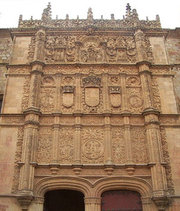University of Salamanca
|
|
Template:Infobox Spanish University The University of Salamanca (Spanish Universidad de Salamanca), located in the town of Salamanca, west-northwest of Madrid, is the oldest university in Spain, and one of the oldest in Europe. It was founded by Alfonso IX in 1218.
History
In the reign of Ferdinand, King of Aragon, and Isabella, Queen of Castile, Spanish government was revamped. Apart from the launch of the Spanish Inquisition, expulsion of the Jews, and the conquest of Granada, there was a certain professionalization of the apparatus of the state. This involved the employment of letrados, lettered men, who were licenciados (graduates) of the Universities, especially of Salamanca and Alcala de Henares. These men staffed the various councils of state, including, eventually, the Consejo de Indias and Casa de Contratacion, the two highest bodies in metropolitan Spain for the government of the Spanish empire in the New World.
When Columbus was lobbying the King and Queen for a contract to go find a Western route to the Indies, he made his case to a council of geographers at the University of Salamanca.
At the end of the Spanish Golden Age (1550-1650), the quality of academics in all the Spanish universities declined. Professors and students rarely attended class, the frequency of degree awards dropped, and their prestige receded.
However, today the Universidad de Salamanca is considered one of Europe's premier research universities.
See also
External link
- University website (http://www.usal.es/)
| Coimbra Group (of European research universities) | 
|
|---|---|
| Aarhus | Barcelona | Bergen | Bologna | Bristol | Budapest | Cambridge | Coimbra | Dublin | Edinburgh | Galway | Geneva | Göttingen | Granada | Graz | Groningen | Heidelberg | Jena | Kraków | Leiden | Leuven | Louvain | Lyon | Montpellier | Oxford | Padua | Pavia | Poitiers | Prague | Salamanca | Siena | Tartu | Thessaloniki | Turku I | Turku II | Uppsala | Würzburg | |

